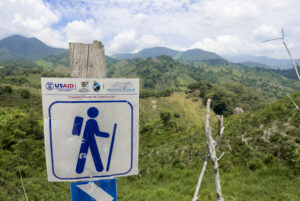Central America- Dominican Republic Free Trade Agreement
What is CAFTA-DR?
The purported aim of DR-CAFTA (Dominican Republic-Central American Free Trade Agreement) is to liberalize U.S. and Central America markets, creating a free-trade zone similar to that created between the US, Mexico and Canada as a result of the North American Free Trade Agreement (NAFTA).
DR-CAFTA provisions eliminate tariffs on basic grains, such as rice, beans and corns both immediately and gradually depending on country and product specific agreements. As such, the agreement particularly affects the rural sector throughout Latin America where small farmers are unable to compete with subsidized agricultural imports from the U.S. This has very troubling implications for poverty and development in a region that is predominantly rural and agriculture based.
Signatories to DR-CAFTA include: the U.S., Guatemala, El Salvador, Nicaragua, Honduras, Dominican Republic and Costa Rica. Costa Rica is the only country that has not ratified the agreement. The delay in Costa Rica’s implementation has been attributed, in part, to significant ongoing opposition from sectors of civil society. Despite strong public opinion against the agreement, President Oscar Arias is reportedly pushing for it to be ratified sometime before May 2007.
Country implementation occurred as follows: El Salvador, March 1, 2006; Guatemala, June 1, 2006; Honduras, April 1, 2006; Nicaragua, April 1, 2006; Dominican Republic, March 1, 2007.
Central America- Dominican Republic Free Trade Agreement
What is CAFTA-DR?
The purported aim of DR-CAFTA (Dominican Republic-Central American Free Trade Agreement) is to liberalize U.S. and Central America markets, creating a free-trade zone similar to that created between the US, Mexico and Canada as a result of the North American Free Trade Agreement (NAFTA).
DR-CAFTA provisions eliminate tariffs on basic grains, such as rice, beans and corns both immediately and gradually depending on country and product specific agreements. As such, the agreement particularly affects the rural sector throughout Latin America where small farmers are unable to compete with subsidized agricultural imports from the U.S. This has very troubling implications for poverty and development in a region that is predominantly rural and agriculture based.
Signatories to DR-CAFTA include: the U.S., Guatemala, El Salvador, Nicaragua, Honduras, Dominican Republic and Costa Rica.
Country implementation occurred as follows: El Salvador, March 1, 2006; Guatemala, June 1, 2006; Honduras, April 1, 2006; Nicaragua, April 1, 2006; Dominican Republic, March 1, 2007.
COSTA RICA
Costa Rica is the only country that has not ratified the agreement. The delay in Costa Rica’s implementation has been rooted in significant ongoing opposition from a wide range of civil society groups. Though DR-CAFTA was a divisive issue from the onset of negotiations, it became a nation-wide debate during the 2006 Costa Rican presidential elections between now-President Óscar Arias and opposition candidate Ottón Solís of the Costa Rican Citizen’s Action Party. Solis, who ran on an “anti-CAFTA” platform, came within a mere 3250 votes of the Presidency. Since then, the opposition to DR-CAFTA has remained strong, with a nation-wide coalition organizing frequent protests and marches in response to a flurry of legal decisions paving the way for an October 7 2007 referendum.
Casas and Sanchez Memo
In early Sept 2007. an incriminating memo addressed to Costa Rican President Oscar Arias from party officials was leaked to the press. Written by Vice President, Kevin Casas and representative and President of the Electoral Commission, Fernando Sanchez, the letter outlines recommendations for how the Arias administration should combat the anti-CAFTA movement in the final months preceding the referendum. The proposed strategies include isolating local mayors and a campaign of fear promoting stark economic repercussions if CAFTA is not approved.
Fast Track Negotiations
The Bush Administration aggressively pursued the DR-CAFTA negotiations on a very short timeline; whereas NAFTA took more than seven years to negotiate and the FTAA has been negotiated for almost a decade, DR-CAFTA was completed in one calendar year, with limited civil society or Congressional participation. Negotiations for CAFTA began in January 2003, shortly after the U.S. Congress approved a bill to confer Trade Promotion Authority (or “Fast Track”) to the White House. Under “Fast Track,” Congress is limited to an up or down vote and cannot amend a trade agreement. The agreement was signed on May 28, 2004 in Washington D.C. All signatory nations have approved the agreement except for Costa Rica, where civil society opposition continues to be very strong, and this far, has delayed the agreement's implementation.
An Asymmetric Agreement
CAFTA is the first “sub-regional” agreement to be negotiated between such unequal trading partners, where the combined GDP of Central America is equal to 0.5 percent of U.S. GDP. CAFTA would require market liberalization for the majority of goods and services in Central America—including agriculture, manufacturing, public services and government procurement. In return, the U.S. has promised increased market access for certain sectors in Central America, including textiles and a limited increase in sugar quotas. Rigorous impact assessments of CAFTA have not been conducted in Central America. Rather, Central Americans are forced to judge the potential impact based upon the ten-year record of NAFTA. Analysts expect that–as occurred in Mexico–CAFTA will attract foreign direct investment and boost Central American exports in certain sectors, but will provide little benefit to the rural and urban poor of the region.
This packet includes 12 chapters which each address specific issues such as labor, the rural sector and gender, within the context of the Central American Free Trade Agreement
The following are additional WOLA documents and statements on CAFTA
Statement regarding CAFTA's potential effects on Central America's rural sector
Principles of Unity on Trade with Central America DR-CAFTA
Equitable Trade in Central America- Does CAFTA Measure up?

